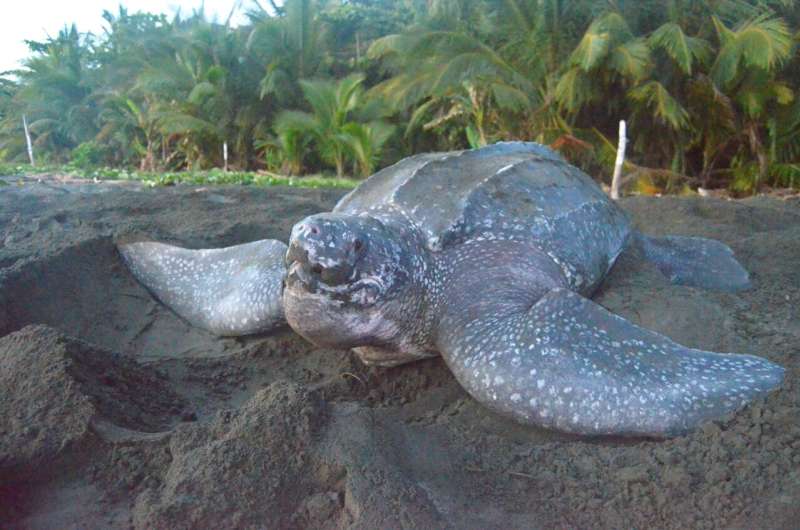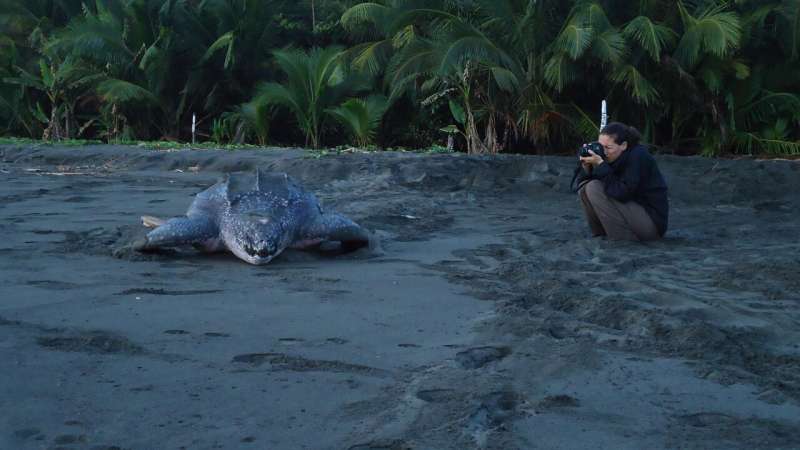This article has been reviewed according to Science X's editorial process and policies. Editors have highlighted the following attributes while ensuring the content's credibility:
fact-checked
peer-reviewed publication
trusted source
proofread
Sea level rises could threaten sea turtle breeding grounds

Sea level rises could lead to the flooding of sea turtle breeding grounds in Australia, Dominican Republic, Costa Rica and the U.S., according to a study published in Scientific Reports. The findings suggest that flooding could contribute to the loss of turtle nesting sites and that leatherback turtle nests may be particularly vulnerable.
Marga Rivas and colleagues estimated the probability of flooding under moderate and high greenhouse gas emission scenarios between 2010 and 2100 at 2,835 sea turtle nest locations within seven breeding grounds. Breeding grounds were located in Mondonguillo beach (Costa Rica), Guanahacabibes peninsula (Cuba), Saona Island (Dominican Republic), the coast of Ecuador, Raine Island (Australia), St George Island (Florida, U.S.) and Sint Eustatius (Caribbean Netherlands). Breeding grounds were used by five sea turtle species—leatherback, loggerhead, hawksbill, olive ridley, and green.
The authors found that under a moderate emissions scenario (Representative Concentration Pathway [RCP] 4.5), breeding grounds located on flat beaches were most vulnerable to flooding, with 100% of nests located on Raine Island and Saona Island—within breeding grounds at low elevations on flat beaches—estimated to be vulnerable to flooding by 2050. Under the same emissions scenario, the authors estimate that 100% of nest locations at St George Island and Mondonguillo beach may also be vulnerable to flooding.
Within breeding grounds used by multiple turtle species, the authors estimate that leatherback turtle nests may be particularly vulnerable to flooding due to differences in the nesting locations preferred by each species. Leatherback turtles tend to nest in open areas near the hide tide line, while hawksbill and green turtles tend to nest at higher elevations closer to dunes and steep cliffs. In St Eustatius, the authors therefore estimate that under a moderate emissions scenario, on average, 50% of leatherback, 18% of hawksbill, and 13% of green turtle nest locations may be vulnerable to flooding by 2050.
As female sea turtles return to nest on the same beaches they hatched on, the authors speculate that sea level rises could lead to many turtles nesting on flooded beaches and that this could negatively impact the number of turtles hatching. They note that the long-term impacts of this on sea turtle populations are currently unclear as further research is needed to investigate how quickly turtles may adapt to the flooding of nesting habitat.

The authors suggest that their findings highlight the need for strategies to mitigate the impacts of sea levels rises and enhance sea turtle resilience such as sand refilling on nesting beaches, nest relocation, and the use of turtle hatcheries.
More information: Marga Rivas, Uncertain future for global sea turtle populations in face of sea level rise, Scientific Reports (2023). DOI: 10.1038/s41598-023-31467-1. www.nature.com/articles/s41598-023-31467-1
Journal information: Scientific Reports
Provided by Nature Publishing Group


















